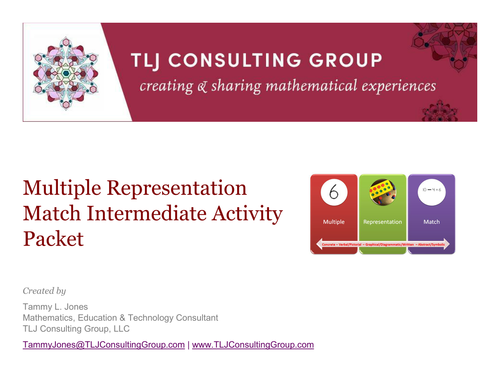

NCTM describes “representation” as referring to both a process and a product. So mathematical representations include all the different ways that students depict their thinking as well as the processes they use to put their thinking into those forms. Representations have often been taught as an end in and of themselves, most as essential elements in supporting students’ understanding. When students gain access to mathematical representations and the ideas they express they acquire a set of tools that significantly expand their capacity to model and interpret physical, social, and mathematical phenomena.
The place value activity takes two- and three-digit numbers and represents them through a concrete manipulative, the written symbol, a verbal symbol, a diagram, picture, graph, drawing, or table, and an algebraic representation with a mathematical sentence. There is also a contextual problem for the students to work through. There are six sets of cards, each with 6 representations with facilitation notes. The fraction activity takes common fractions and represents them through a concrete manipulative, a verbal symbol, a fraction model, a number line representation, and a symbolic representation. There is also a contextual problem for the students to work through. There are five sets of cards, each with 6 representations with facilitation notes.
This resource is good for students with Dyslexia and language-based learning deficiencies. We'd like to hear about your experience with our resources. Just give it a star rating then tell us what you think, simple as that!
The place value activity takes two- and three-digit numbers and represents them through a concrete manipulative, the written symbol, a verbal symbol, a diagram, picture, graph, drawing, or table, and an algebraic representation with a mathematical sentence. There is also a contextual problem for the students to work through. There are six sets of cards, each with 6 representations with facilitation notes. The fraction activity takes common fractions and represents them through a concrete manipulative, a verbal symbol, a fraction model, a number line representation, and a symbolic representation. There is also a contextual problem for the students to work through. There are five sets of cards, each with 6 representations with facilitation notes.
This resource is good for students with Dyslexia and language-based learning deficiencies. We'd like to hear about your experience with our resources. Just give it a star rating then tell us what you think, simple as that!
Something went wrong, please try again later.
This resource hasn't been reviewed yet
To ensure quality for our reviews, only customers who have purchased this resource can review it
Report this resourceto let us know if it violates our terms and conditions.
Our customer service team will review your report and will be in touch.
£5.00
